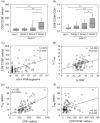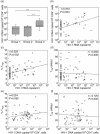Regulatory T cells and chronic immune activation in human immunodeficiency virus 1 (HIV-1)-infected children
- PMID: 21438872
- PMCID: PMC3087933
- DOI: 10.1111/j.1365-2249.2011.04383.x
Regulatory T cells and chronic immune activation in human immunodeficiency virus 1 (HIV-1)-infected children
Abstract
The function of CD4(+) T cells with regulatory activity (T(regs)) is the down-regulation of immune responses. This suppressive activity may limit the magnitude of effector responses, resulting in failure to control human immunodeficiency virus 1 (HIV-1) infection, but may also suppress chronic immune activation, a characteristic feature of HIV-1 disease. We evaluated the correlation between viral load, immune activation and T(regs) in HIV-1-infected children. Eighty-nine HIV-1-infected children (aged 6-14 years) were included in the study and analysed for HIV-1 plasmaviraemia, HIV-1 DNA load, CD4 and CD8 cell subsets. T(reg) cells [CD4(+)CD25(high)CD127(low) forkhead box P3 (FoxP3(high))] and CD8-activated T cells (CD8(+)CD38(+)) were determined by flow cytometry. Results showed that the number of activated CD8(+)CD38(+)T cells increased in relation to HIV-1 RNA plasmaviraemia (r = 0·403, P < 0·0001). The proportion of T(regs) also correlated positively with HIV-1 plasmaviraemia (r = 0·323, P = 0·002), but correlated inversely with CD4(+) cells (r = -0·312, P = 0·004), thus suggesting a selective expansion along with increased viraemia and CD4(+) depletion. Interestingly, a positive correlation was found between the levels of T(regs) and CD8(+)CD38(+)T cells (r = 0·305, P = 0·005), and the percentage of T(regs) tended to correlate with HIV-1 DNA load (r = 0·224, P = 0·062). Overall, these findings suggest that immune activation contributes to the expansion of T(reg) cells. In turn, the suppressive activity of T(regs) may impair effector responses against HIV-1, but appears to be ineffective in limiting immune activation.
© 2011 The Authors; Clinical and Experimental Immunology © 2011 British Society for Immunology.
Figures





References
-
- Hazenberg MD, Otto SA, van Benthem BHB, et al. Persistent immune activation in HIV-1 infection is associated with progression to AIDS. AIDS. 2003;17:1881–8. - PubMed
-
- Douek DC, Picker LJ, Koup RA. T cell dynamics in HIV-1 infection. Annu Rev Immunol. 2003;21:265–304. - PubMed
-
- Hunt PW, Martin JN, Sinclair E, et al. T cell activation is associated with lower CD4+ T cell gains in human immunodeficiency virus-infected patients with sustained viral suppression during antiretroviral therapy. J Infect Dis. 2003;187:1534–43. - PubMed
Publication types
MeSH terms
Substances
LinkOut - more resources
Full Text Sources
Medical
Research Materials

